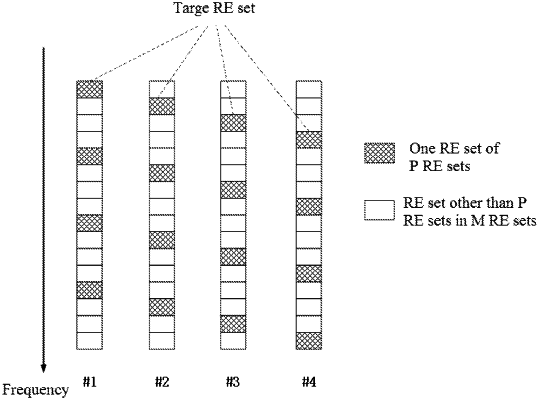| CPC H04L 5/0053 (2013.01) [H04W 72/542 (2023.01); H04L 5/0007 (2013.01); H04L 5/0073 (2013.01); H04L 5/0091 (2013.01)] | 20 Claims |

|
1. A method in a User Equipment (UE) for wireless communications, comprising:
receiving first information from a base station device; and
monitoring a first signaling in M Resource Element (RE) sets, the first signaling being transmitted by the base station device;
wherein:
the first information is used by the UE for determining the M RE sets, the monitoring of the first signaling assumes that P modulation symbol groups are one-to-one mapped to P RE sets, the P RE sets are P RE sets out of the M RE sets, and one blind detection for the first signaling is performed on the P RE sets;
bits in a first bit sequence are modulated by the base station device to obtain modulation symbols that constitute a first modulation symbol set sequentially, wherein the bits in the first bit sequence are sequentially arranged according to an output of a channel encoder;
the first modulation symbol set is divided into the P modulation symbol groups successively from the front to the rear, and each modulation symbol group of the P modulation symbol groups consists of X modulation symbols; and
relative positions of the P RE sets in frequency domain are related to the X, wherein the M is a positive integer greater than 1, the P is a positive integer not greater than the M, the P is greater than 1, and the X is a positive integer greater than 1;
each RE set of the M RE sets consists of 2, 3, or 6 Resource Element Groups (REGs), wherein each REG occupies one multicarrier symbol in time domain and occupies one Physical Resource Block (PRB) in frequency domain; each RE set of the M RE sets includes the same number of Reference Signal (RS) REs;
a first RE set is one of the M RE sets, the REs in the first RE set adopt the same precoding;
the relative positions of the P RE sets in frequency domain refer to a minimum value of the distances between the positions in frequency domain of any two adjacent RE sets of the P RE sets sequentially corresponding to the P modulation symbol groups.
|